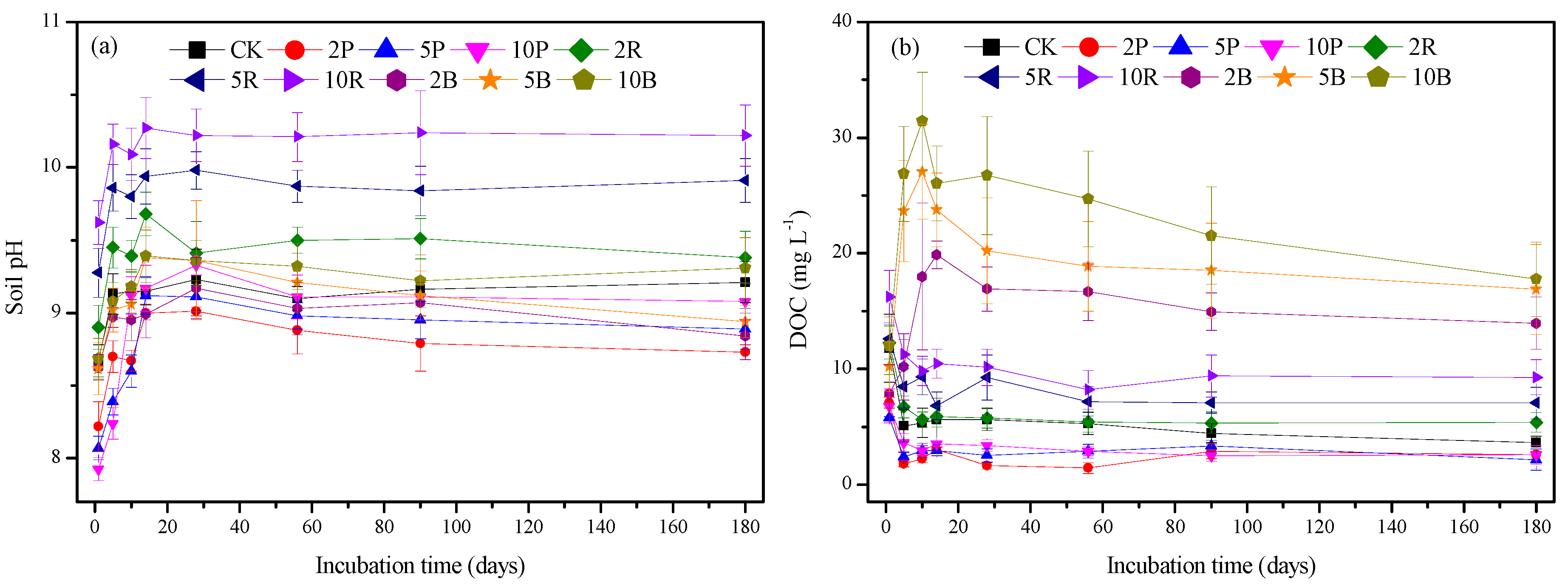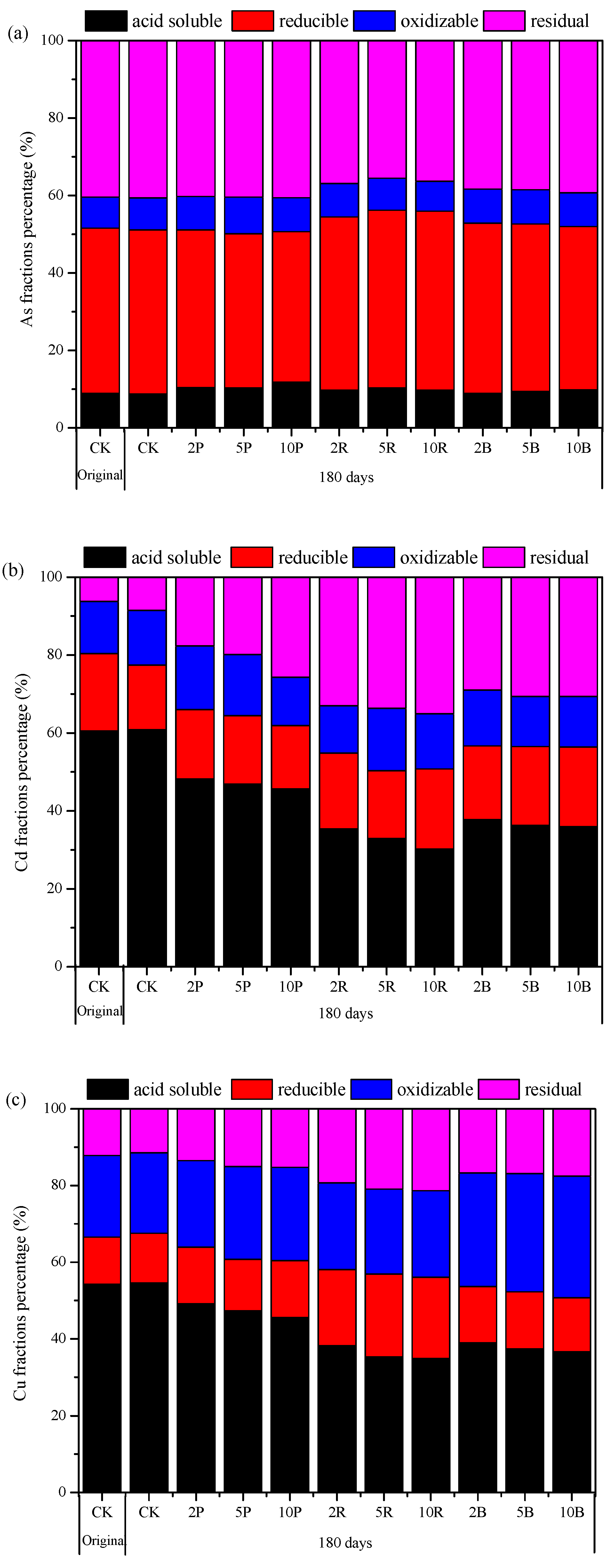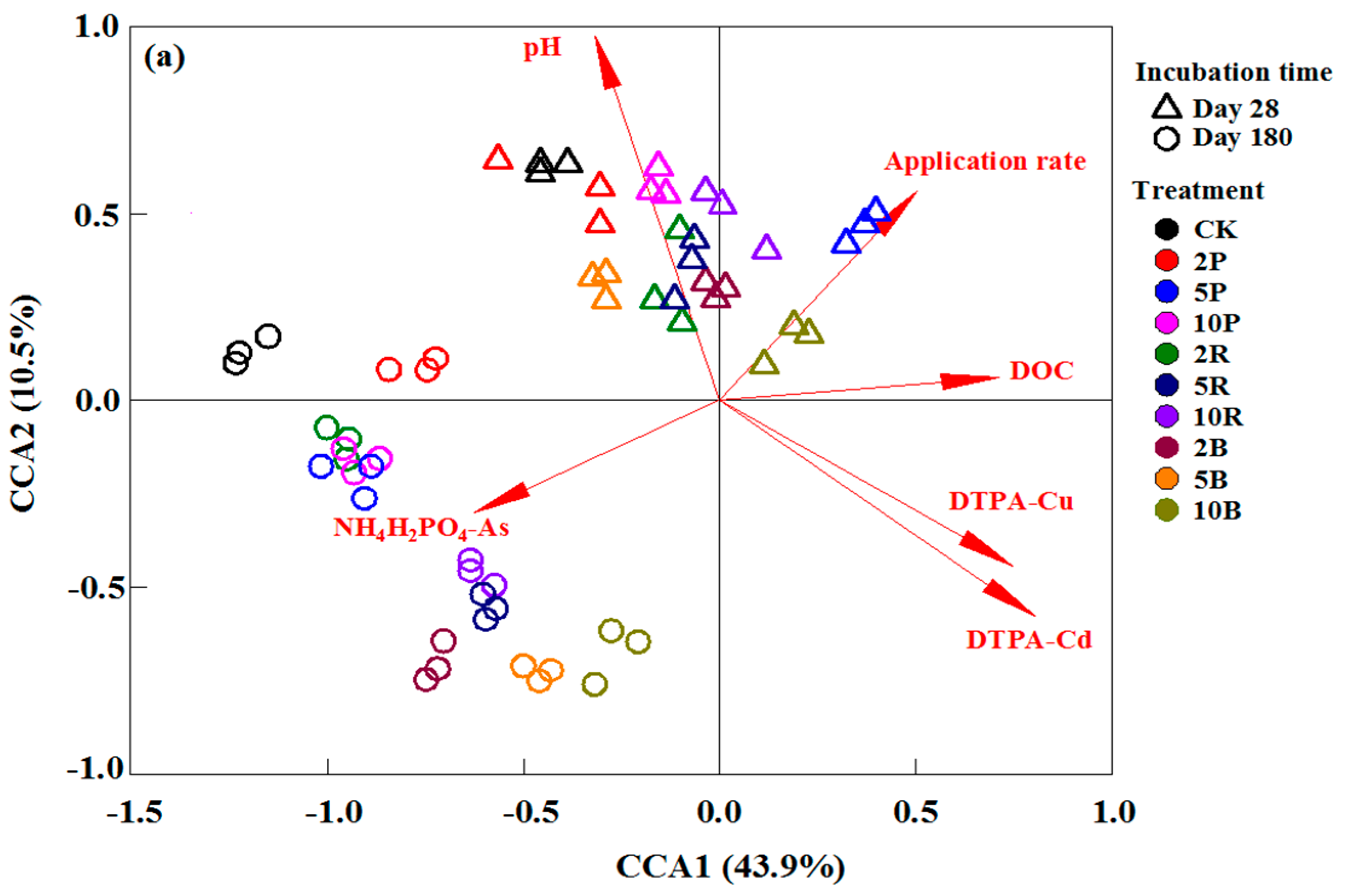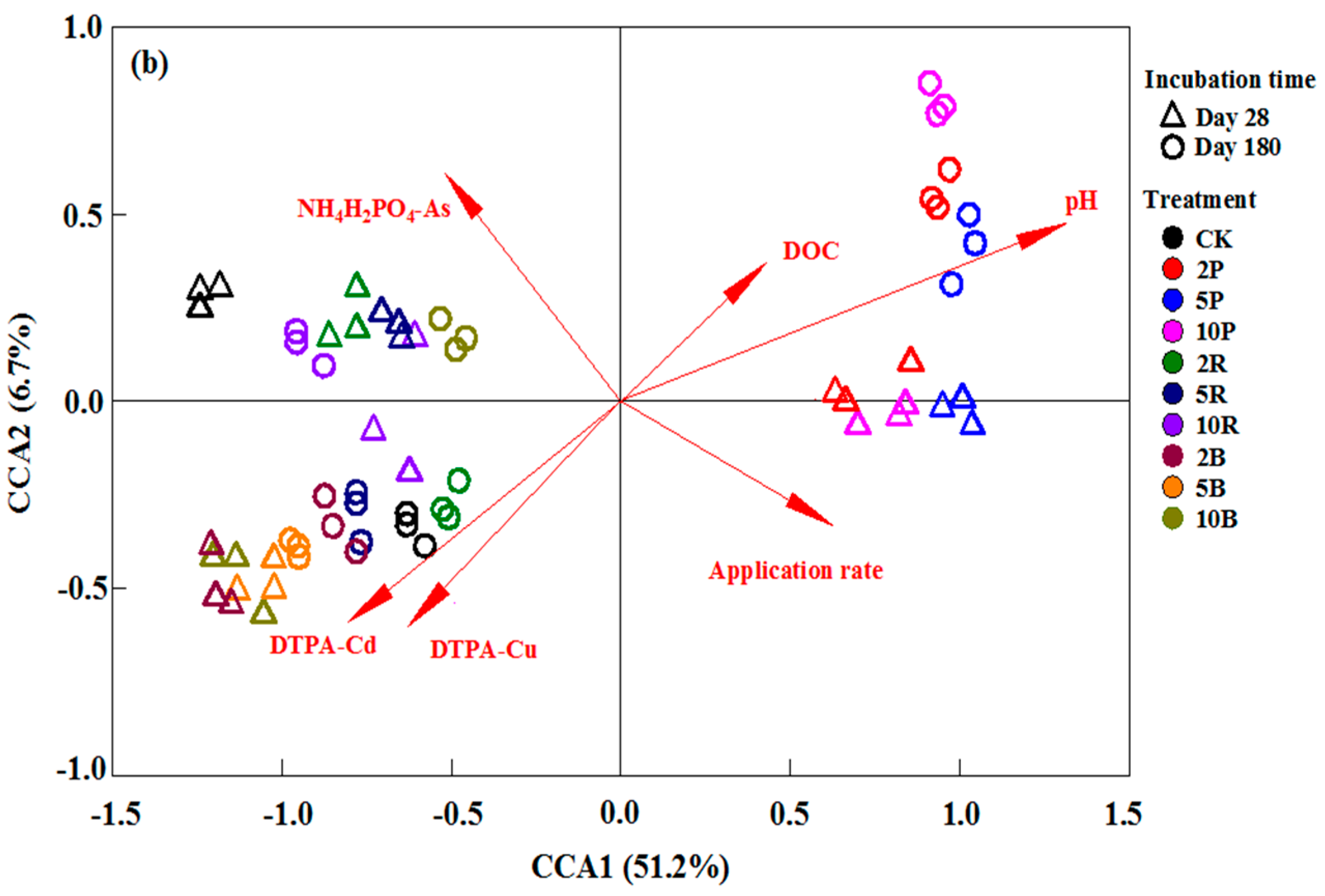Effects of Phosphate, Red Mud, and Biochar on As, Cd, and Cu Immobilization and Enzymatic Activity in a Co-Contaminated Soil
Abstract
:1. Introduction
2. Materials and Methods
2.1. Soil and Amendments
2.2. Experimental Design
2.2.1. Soil Incubation Experiment
2.2.2. Soil Chemical Analysis
2.2.3. Soil Enzymatic Activity Analysis
2.3. Statistical Analysis
3. Results and Discussion
3.1. Effects of Three Amendments on Soil pH and DOC during the Incubation
3.2. Effects of Three Amendments on Chemical Fractions of Soil As, Cd, and Cu
3.3. Effects of Three Amendments on Phytoavailability of Soil As, Cd, and Cu
3.4. Effects of Three Amendments on Soil Enzymatic Activity
3.5. Issues with Real-Scale Application
4. Conclusions
Author Contributions
Funding
Acknowledgments
Conflicts of Interest
References
- Zhou, R.; Liu, X.; Luo, L.; Zhou, Y.; Wei, J.; Chen, A.; Tang, L.; Wu, H.; Deng, Y.; Zhang, F.; et al. Remediation of Cu, Pb, Zn and Cd-contaminated agricultural soil using a combined red mud and compost amendment. Int. Biodeter. Biodegr. 2017, 118, 73–81. [Google Scholar] [CrossRef]
- Du, X.; Gao, L.; Xun, Y.; Feng, L. Comparison of different sequential extraction procedures to identify and estimate bioavailability of arsenic fractions in soil. J. Soil Sediment 2020, 20, 3656–3668. [Google Scholar] [CrossRef]
- Luo, M.; Lin, H.; He, Y.; Zhang, Y. The influence of corncob-based biochar on remediation of arsenic and cadmium in yellow soil and cinnamon soil. Sci. Total Environ. 2020, 717, 137014. [Google Scholar] [CrossRef]
- Shen, B.; Wang, X.; Zhang, Y.; Zhang, M.; Wang, K.; Xie, P.; Ji, H. The optimum pH and Eh for simultaneously minimizing bioavailable cadmium and arsenic contents in soils under the organic fertilizer application. Sci. Total Environ. 2020, 711, 135229. [Google Scholar] [CrossRef]
- Xia, S.P.; Song, Z.L.; Jeyakumar, P.; Shaheen, S.M.; Rinklebe, J.; Ok, Y.S.; Bolan, N.; Wang, H. A critical review on bioremediation technologies for Cr (VI)-contaminated soils and wastewater. Crit. Rev. Environ. Sci. Technol. 2019, 49, 1027–1078. [Google Scholar] [CrossRef]
- Wu, C.; Shi, L.; Xue, S.; Li, W.; Jiang, X.; Rajendran, M.; Qian, Z. Effect of sulfur-iron modified biochar on the available cadmium and bacterial community structure in contaminated soils. Sci. Total Environ. 2019, 647, 1158–1168. [Google Scholar] [CrossRef]
- Yao, A.; Wang, Y.; Ling, X.; Chen, Z.; Tang, Y.; Qiu, H.; Ying, R.; Qiu, R. Effects of an iron-silicon material, a synthetic zeolite and an alkaline clay on vegetable uptake of As and Cd from a polluted agricultural soil and proposed remediation mechanisms. Environ. Geochem. Health 2017, 39, 353–367. [Google Scholar] [CrossRef]
- Derakhshan Nejad, Z.; Rezania, S.; Jung, M.C.; Al-Ghamdi, A.A.; Mustafa, A.; Elshikh, M.S. Effects of fine fractions of soil organic, semi-organic, and inorganic amendments on the mitigation of heavy metal(loid)s leaching and bioavailability in a post-mining area. Chemosphere 2021, 271, 129538. [Google Scholar] [CrossRef]
- Tang, J.Y.; Zhang, L.H.; Zhang, J.C.; Ren, L.H.; Zhou, Y.Y.; Zheng, Y.Y.; Luo, L.; Yang, Y.; Huang, H.L.; Chen, A.W. Physicochemical features, metal availability and enzyme activity in heavy metal-polluted soil remediated by biochar and compost. Sci. Total Environ. 2020, 701, 134751. [Google Scholar] [CrossRef]
- Jiang, Y.; Yi, Y.T.; Liu, M.Y.; Liu, B.B.; Zhou, H.; Zeng, P.; Liao, B.H.; Gu, J.F. Dynamic responses of soil enzymes at key growth stages in rice after the in situ remediation of paddy soil contaminated with cadmium and arsenic. Sci. Total Environ. 2022, 830, 154633. [Google Scholar] [CrossRef]
- Islam, M.; Mishra, P.C.; Patel, R. Physicochemical characterization of hydroxyapatite and its application towards removal of nitrate from water. J. Environ. Manag. 2010, 91, 1883–1891. [Google Scholar] [CrossRef]
- Mignardi, S.; Corami, A.; Ferrini, V. Evaluation of the effectiveness of phosphate treatment for the remediation of mine waste soils contaminated with Cd, Cu, Pb, and Zn. Chemosphere 2012, 86, 354–360. [Google Scholar] [CrossRef]
- Nie, Q.K.; Li, Y.D.; Wang, G.H.; Bai, B. Physicochemical and microstructural properties ofred muds under acidic and alkaline conditions. Appl. Sci. 2021, 10, 2993. [Google Scholar] [CrossRef]
- Yang, T.; Wang, Y.; Sheng, L.; He, C.; Sun, W.; He, Q. Enhancing Cd (II) sorption by red mud with heat treatment: Performance and mechanisms of sorption. J. Environ. Manag. 2020, 255, 109866. [Google Scholar] [CrossRef]
- Cho, D.W.; Yoon, K.; Ahn, Y.; Sun, Y.; Tsang, D.C.W.; Hou, D.; Ok, Y.S.; Song, H. Fabrication and environmental applications of multifunctional mixed metal biochar composites (MMBC) from red mud and lignin wastes. J. Hazard. Mater. 2019, 374, 412–419. [Google Scholar] [CrossRef]
- Hua, Y.; Heal, K.V.; Friesl-Hanl, W. The use of red mud as an immobilizer for metal/metalloid-contaminated soil: A review. J. Hazard. Mater. 2017, 325, 17–30. [Google Scholar] [CrossRef] [Green Version]
- Pavel, P.B.; Puschenreiter, M.; Wenzel, W.W.; Diacu, E.; Barbu, C.H. Aided phytostabilization using Miscanthus sinensis× giganteus on heavy metal contaminatedsoils. Sci. Total Environ. 2014, 479, 125–131. [Google Scholar] [CrossRef]
- Chen, W.; Meng, J.; Han, X.; Lan, Y.; Zhang, W. Past, present, and future of biochar. Biochar 2019, 1, 75–87. [Google Scholar] [CrossRef] [Green Version]
- Wu, J.; Li, Z.; Huang, D.; Liu, X.; Tang, C.; Parikh, S.J.; Xu, J. A novel calcium-based magnetic biochar is effective in stabilization of arsenic and cadmium co-contamination in aerobic soils. J. Hazard. Mater. 2020, 387, 122010. [Google Scholar] [CrossRef]
- Novak, J.M.; Ippolito, J.A.; Watts, D.W.; Sigua, G.C.; Ducey, T.F.; Johnson, M.G. Biochar compost blends facilitate switchgrass growth in mine soils by reducing Cd and Zn bioavailability. Biochar 2019, 1, 97–114. [Google Scholar] [CrossRef] [Green Version]
- Liu, Y.J.; Naidu, R.; Ming, H.; Dharmarajan, R.; Du, J.H. Effects of thermal treatments on the characterisation and utilisation of red mud with sawdust additive. Waste Manag. Res. 2016, 34, 518–526. [Google Scholar] [CrossRef] [PubMed]
- Luo, D.; Zheng, H.; Chen, Y.; Wang, G.; Fenghua, D. Transfer characteristics of cobalt from soil to crops in the suburban areas of Fujian Province, southeast China. J. Environ. Manag. 2010, 91, 2248–2253. [Google Scholar] [CrossRef] [PubMed]
- Bashir, S.; Shaaban, M.; Hussain, Q.; Mehmood, S.; Zhu, J.; Fu, Q.; Aziz, O.; Hu, H. Influence of organic and inorganic passivators on Cd and Pb stabilization and microbial biomass in a contaminated paddy soil. J. Soil Sediment 2018, 18, 2948–2959. [Google Scholar] [CrossRef]
- Tu, C.; Wei, J.; Guan, F.; Liu, Y.; Sun, Y.; Luo, Y. Biochar and bacteria inoculated biochar enhanced Cd and Cu immobilization and enzymatic activity in a polluted soil. Environ. Int. 2020, 137, 105576. [Google Scholar] [CrossRef] [PubMed]
- Sun, Y.; Sun, G.; Xu, Y.; Wang, L.; Liang, X.; Lin, D. Assessment of sepiolite for immobilization of cadmium-contaminated soils. Geoderma 2013, 193, 149–155. [Google Scholar] [CrossRef]
- Xu, Z.M.; Zhang, Y.X.; Wang, L.; Liu, C.G.; Sun, W.M.; Wang, Y.F.; Long, S.X.; He, X.T.; Lin, Z.; Liang, J.L.; et al. Rhizobacteria communities reshaped by red mud based passivators is vital for reducing soil Cd accumulation in edible amaranth. Sci. Total Environ. 2022, 826, 154002. [Google Scholar] [CrossRef]
- Jing, F.; Chen, X.; Wen, X.; Liu, W.; Hu, S.; Yang, Z.; Guo, B.; Luo, Y.; Yu, Q.; Xu, Y. Biochar effects on soil chemical properties and mobilization of cadmium (Cd) and lead (Pb) in paddy soil. Soil Use Manag. 2020, 36, 320–327. [Google Scholar] [CrossRef]
- Anawar, H.M.; Rengel, Z.; Damon, P.; Tibbett, M. Arsenic-phosphorus interactions in the soil-plant-microbe system: Dynamics of uptake, suppression and toxicity to plants. Environ. Pollut. 2018, 233, 1003–1012. [Google Scholar] [CrossRef]
- Strawn, D.G. Review of interactions between phosphorus and arsenic in soils from four case studies. Geochem. Trans. 2018, 19, 1–13. [Google Scholar] [CrossRef] [Green Version]
- Wang, H.; Wang, X.; Li, J.; Jing, H.; Xia, S.; Liu, F.; Zhao, J. Comparison of palygorskite and struvite supported palygorskite derived from phosphate recovery in wastewater for in-situ immobilization of Cu, Pb and Cd in contaminated soil. J. Hazard. Mater. 2018, 346, 273–284. [Google Scholar] [CrossRef]
- Xu, Z.; Lu, Z.; Zhang, L.; Fan, H.; Wang, Y.; Li, J.; Lin, Y.; Liu, H.; Guo, S.; Xu, M.; et al. Red mud based passivator reduced Cd accumulation in edible amaranth by influencing root organic matter metabolism and soil aggregate distribution. Environ. Pollut. 2021, 275, 116543. [Google Scholar] [CrossRef] [PubMed]
- Nie, C.; Yang, X.; Niazi, N.K.; Xu, X.; Wen, Y.; Rinklebe, J.; Ok, Y.S.; Xu, S.; Wang, H. Impact of sugarcane bagasse-derived biochar on heavy metal availability and microbial activity: A field study. Chemosphere 2018, 200, 274–282. [Google Scholar] [CrossRef] [PubMed]
- Liang, J.; Yang, Z.; Tang, L. Changes in heavy metal mobility and availability from contaminated wetland soil remediated with combined biochar-compost. Chemosphere 2017, 181, 281. [Google Scholar] [CrossRef] [PubMed]
- Zhao, S.; Feng, C.; Wang, D. Salinity increases the mobility of Cd, Cu, Mn, and Pb in the sediments of Yangtze Estuary: Relative role of sediments’ properties and metal speciation. Chemosphere 2013, 91, 977–984. [Google Scholar] [CrossRef]
- Li, H.; Wu, W.; Min, X.; Zhan, W.; Fang, T.; Dong, X.; Shi, Y. Immobilization and assessment of heavy metals in chicken manure compost amended with rice straw-derived biochar. Environ. Pollut. Bioavail. 2021, 33, 1–10. [Google Scholar] [CrossRef]
- Wu, J.; Liang, J.; Bjorn, L.O.; Li, J.; Shu, W.; Wang, Y. Phosphorus-arsenic interaction in the ‘soil-plant-microbe’ system and its influence on arsenic pollution. Sci. Total Environ. 2022, 802, 149796. [Google Scholar] [CrossRef]
- Deng, Y.; Li, Y.; Li, X.; Sun, Y.; Ma, J.; Lei, M.; Weng, L. Influence of calcium and phosphate on pH dependency of arsenite and arsenate adsorption to goethite. Chemosphere 2018, 199, 617–624. [Google Scholar] [CrossRef]
- Pincus, L.N.; Petrović, P.V.; Gonzalez, I.S.; Stavitski, E.; Fishman, Z.S.; Rudel, H.E.; Anastas, P.T.; Zimmerman, J.B. Selective adsorption of arsenic over phosphate by transition metal cross-linked chitosan. Chem. Eng. J. 2021, 412, 128582. [Google Scholar] [CrossRef]
- Han, Y.S.; Park, J.H.; Min, Y.; Lim, D.H. Competitive adsorption between phosphate and arsenic in soil containing iron sulfide: XAS experiment and DFT calculation approaches. Chem. Eng. J. 2020, 397, 125426. [Google Scholar] [CrossRef]
- Rubinos, D.A.; Spagnoli, G. Assessment of red mud as sorptive landfill liner for the retention of arsenic (V). J. Environ. Manag. 2019, 232, 271–285. [Google Scholar] [CrossRef]
- Ding, Y.Z.; Wang, Y.G.; Zheng, X.Q.; Cheng, W.M.; Shi, R.G.; Feng, R.W. Effects of foliar dressing of selenite and silicate alone or combined with different soil ameliorants on the accumulation of As and Cd and antioxidant system in Brassica campestris. Ecotox. Environ. Saf. 2017, 142, 207–215. [Google Scholar] [CrossRef] [PubMed]
- Derakhshan Nejad, Z.; Kim, J.W.; Jung, M.C. Reclamation of arsenic contaminated soils around mining site using solidification/stabilization combined with revegetation. Geosci. J. 2017, 21, 385–396. [Google Scholar] [CrossRef]
- Tu, C.; Guan, F.; Sun, Y.; Guo, P.; Liu, Y.; Li, L.; Scheckel, K.G.; Luo, Y. Stabilizing Effects on a Cd Polluted Coastal Wetland Soil using Calcium Polysulphide. Geoderma 2018, 332, 190–197. [Google Scholar] [CrossRef] [PubMed]
- Bhaduri, D.; Saha, A.; Desai, D.; Meena, H.N. Restoration of carbon and microbial activity in salt-induced soil by application of peanut shell biochar during short-term incubation study. Chemosphere 2016, 148, 86–98. [Google Scholar] [CrossRef]
- Tang, B.; Xu, H.P.; Song, F.M.; Ge, H.G.; Chen, L.; Yue, S.Y.; Yang, W.S. Effect of biochar on immobilization remediation of Cd contaminated soiland environmental quality. Environ. Res. 2022, 204, 111840. [Google Scholar] [CrossRef]
- Setyo, B.K.; Nur, N.R.; Nor Sakinah, M.S.; Jahira, A.; Muhammad, F.I.; Siti Rozaimah, S.A.; Ahmad, R.O.; Ipung, F.P.; Hassimi, A.H. Practical limitations of bioaugmentation in treating heavy metal contaminated soil and role of plant growth promoting bacteria in phytoremediation as a promising alternative approach. Heliyon 2022, 8, e08995. [Google Scholar]
- Xu, J.; Liu, C.; Hsu, P.C.; Zhao, J.; Wu, T.; Tang, J.; Liu, K.; Cui, Y. Remediation of heavy metal contaminated soil by asymmetrical alternating current electrochemistry. Nat. Commun. 2019, 10, 2440. [Google Scholar] [CrossRef] [Green Version]






| pH (1:5) | Surface Area (m2 g−1) | Organic Carbon (g kg−1) | Total As (mg kg−1) | Total Cd (mg kg−1) | Total Cu (mg kg−1) | |
|---|---|---|---|---|---|---|
| Phosphate | 4.62 | – | – | ND | ND | ND |
| Red mud | 10.48 | 24.3 | 5.17 | 1.66 | 0.05 | 2.13 |
| Biochar | 8.81 | 1.58 | 335.5 | 0.07 | ND | 0.12 |
Publisher’s Note: MDPI stays neutral with regard to jurisdictional claims in published maps and institutional affiliations. |
© 2022 by the authors. Licensee MDPI, Basel, Switzerland. This article is an open access article distributed under the terms and conditions of the Creative Commons Attribution (CC BY) license (https://creativecommons.org/licenses/by/4.0/).
Share and Cite
Zhang, D.; Yan, K.; Liu, Y.; Naidu, R. Effects of Phosphate, Red Mud, and Biochar on As, Cd, and Cu Immobilization and Enzymatic Activity in a Co-Contaminated Soil. Processes 2022, 10, 1127. https://doi.org/10.3390/pr10061127
Zhang D, Yan K, Liu Y, Naidu R. Effects of Phosphate, Red Mud, and Biochar on As, Cd, and Cu Immobilization and Enzymatic Activity in a Co-Contaminated Soil. Processes. 2022; 10(6):1127. https://doi.org/10.3390/pr10061127
Chicago/Turabian StyleZhang, Di, Kaihong Yan, Yanju Liu, and Ravi Naidu. 2022. "Effects of Phosphate, Red Mud, and Biochar on As, Cd, and Cu Immobilization and Enzymatic Activity in a Co-Contaminated Soil" Processes 10, no. 6: 1127. https://doi.org/10.3390/pr10061127





